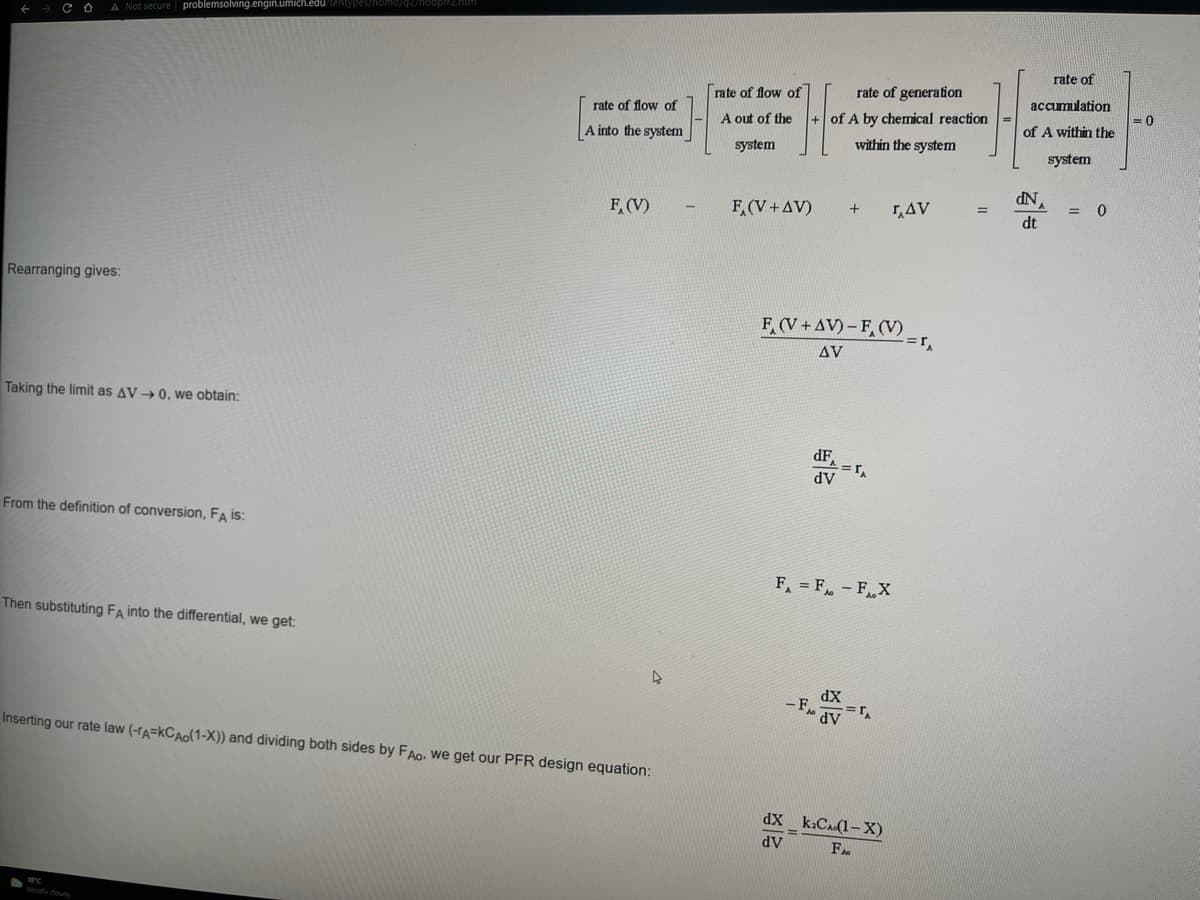For the design equation for a plug flow reactor I don’t understand one of the steps. Can you please explain how FA is substituted to get the equation with dX ?
For the design equation for a plug flow reactor I don’t understand one of the steps. Can you please explain how FA is substituted to get the equation with dX ?
Introduction to Chemical Engineering Thermodynamics
8th Edition
ISBN:9781259696527
Author:J.M. Smith Termodinamica en ingenieria quimica, Hendrick C Van Ness, Michael Abbott, Mark Swihart
Publisher:J.M. Smith Termodinamica en ingenieria quimica, Hendrick C Van Ness, Michael Abbott, Mark Swihart
Chapter1: Introduction
Section: Chapter Questions
Problem 1.1P
Related questions
Question
100%
For the design equation for a plug flow reactor I don’t understand one of the steps. Can you please explain how FA is substituted to get the equation with dX ?

Transcribed Image Text:Со A Not secure problemsolving.engin.umich.
problemsolving.engin.umich.edu/tentypes/hom
rate of flow of
A into the system
F, (V)
-
Rearranging gives:
Taking the limit as AV→ 0, we obtain:
From the definition of conversion, FA is:
Then substituting FA into the differential, we get:
4
Inserting our rate law (-rA-KCAO(1-X)) and dividing both sides by FAo. we get our PFR design equation:
WC
Mostly cloudy
rate of flow of
A out of the
system
rate of generation
+of A by chemical reaction
within the system
+ TAV
=
F, (V+AV)
F(V+AV)-F (V)
AV
=r₁
dF
=r₁
dv
F₁ = FA - FAX
dX
-F
TA
dv
dX_k₂CA (1-X)
dV
FA
rate of
accumulation
= 0
of A within the
system
dN₁
dt
= 0
Expert Solution
This question has been solved!
Explore an expertly crafted, step-by-step solution for a thorough understanding of key concepts.
Step by step
Solved in 2 steps with 2 images

Recommended textbooks for you

Introduction to Chemical Engineering Thermodynami…
Chemical Engineering
ISBN:
9781259696527
Author:
J.M. Smith Termodinamica en ingenieria quimica, Hendrick C Van Ness, Michael Abbott, Mark Swihart
Publisher:
McGraw-Hill Education

Elementary Principles of Chemical Processes, Bind…
Chemical Engineering
ISBN:
9781118431221
Author:
Richard M. Felder, Ronald W. Rousseau, Lisa G. Bullard
Publisher:
WILEY

Elements of Chemical Reaction Engineering (5th Ed…
Chemical Engineering
ISBN:
9780133887518
Author:
H. Scott Fogler
Publisher:
Prentice Hall

Introduction to Chemical Engineering Thermodynami…
Chemical Engineering
ISBN:
9781259696527
Author:
J.M. Smith Termodinamica en ingenieria quimica, Hendrick C Van Ness, Michael Abbott, Mark Swihart
Publisher:
McGraw-Hill Education

Elementary Principles of Chemical Processes, Bind…
Chemical Engineering
ISBN:
9781118431221
Author:
Richard M. Felder, Ronald W. Rousseau, Lisa G. Bullard
Publisher:
WILEY

Elements of Chemical Reaction Engineering (5th Ed…
Chemical Engineering
ISBN:
9780133887518
Author:
H. Scott Fogler
Publisher:
Prentice Hall


Industrial Plastics: Theory and Applications
Chemical Engineering
ISBN:
9781285061238
Author:
Lokensgard, Erik
Publisher:
Delmar Cengage Learning

Unit Operations of Chemical Engineering
Chemical Engineering
ISBN:
9780072848236
Author:
Warren McCabe, Julian C. Smith, Peter Harriott
Publisher:
McGraw-Hill Companies, The